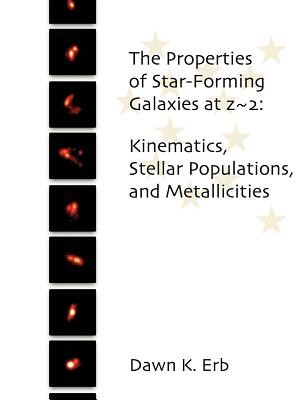
- We will send in 10–14 business days.
- Author: Dawn Erb
- Publisher: Dissertation.Com. - Do Not Use
- ISBN-10: 1581122977
- ISBN-13: 9781581122978
- Format: 18.9 x 24.6 x 0.9 cm, minkšti viršeliai
- Language: English
- SAVE -10% with code: EXTRA
Reviews
Description
We study the properties of star-forming galaxies at redshift z 2, an era in which a substantial fraction of the stellar mass in the universe formed. Using 114 near-IR spectra of the H-alpha and [N II] emission lines and model spectral energy distributions fit to rest-frame UV through IR photometry, we examine the galaxies' star formation properties, dynamical masses and velocity dispersions, spatially resolved kinematics, outflow properties, and metallicities as a function of stellar mass and age. While the stellar masses of the galaxies in our sample vary by a factor of 500, dynamical masses from H-alpha velocity dispersions and indirect estimates of gas masses imply that the variation of stellar mass is due as much to the evolution of the stellar population and the conversion of gas into stars as to intrinsic differences in the total masses of the galaxies. About 10% of the galaxies are apparently young starbursts with high gas fractions, caught just as they have begun to convert large amounts of gas into stars. Using the [N II]/H-alpha ratio of composite spectra to estimate the average oxygen abundance, we find a monotonic increase in metallicity with stellar mass. From the estimated gas fractions, we conclude that the observed mass-metallicity relation is primarily driven by the increase in metallicity as gas is converted to stars. The picture that emerges is of galaxies with a broad range in stellar population properties, from young galaxies with ages of a few tens of Myr, stellar masses M 10^9 Msun, and metallicities Z 1/3 Zsun, to massive objects with M* 10^11 Msun, Z Zsun, and ages as old as the universe allows. All, however, are rapidly star-forming, power galactic-scale outflows, and have masses in gas and stars of at least 10^10 Msun, in keeping with their likely role as the progenitors of elliptical galaxies seen today.
EXTRA 10 % discount with code: EXTRA
The promotion ends in 21d.22:45:07
The discount code is valid when purchasing from 10 €. Discounts do not stack.
- Author: Dawn Erb
- Publisher: Dissertation.Com. - Do Not Use
- ISBN-10: 1581122977
- ISBN-13: 9781581122978
- Format: 18.9 x 24.6 x 0.9 cm, minkšti viršeliai
- Language: English English
We study the properties of star-forming galaxies at redshift z 2, an era in which a substantial fraction of the stellar mass in the universe formed. Using 114 near-IR spectra of the H-alpha and [N II] emission lines and model spectral energy distributions fit to rest-frame UV through IR photometry, we examine the galaxies' star formation properties, dynamical masses and velocity dispersions, spatially resolved kinematics, outflow properties, and metallicities as a function of stellar mass and age. While the stellar masses of the galaxies in our sample vary by a factor of 500, dynamical masses from H-alpha velocity dispersions and indirect estimates of gas masses imply that the variation of stellar mass is due as much to the evolution of the stellar population and the conversion of gas into stars as to intrinsic differences in the total masses of the galaxies. About 10% of the galaxies are apparently young starbursts with high gas fractions, caught just as they have begun to convert large amounts of gas into stars. Using the [N II]/H-alpha ratio of composite spectra to estimate the average oxygen abundance, we find a monotonic increase in metallicity with stellar mass. From the estimated gas fractions, we conclude that the observed mass-metallicity relation is primarily driven by the increase in metallicity as gas is converted to stars. The picture that emerges is of galaxies with a broad range in stellar population properties, from young galaxies with ages of a few tens of Myr, stellar masses M 10^9 Msun, and metallicities Z 1/3 Zsun, to massive objects with M* 10^11 Msun, Z Zsun, and ages as old as the universe allows. All, however, are rapidly star-forming, power galactic-scale outflows, and have masses in gas and stars of at least 10^10 Msun, in keeping with their likely role as the progenitors of elliptical galaxies seen today.


Reviews